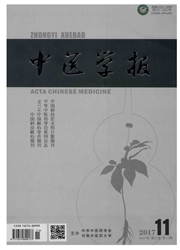

 中文摘要:
中文摘要:
目的:比较针刺不同腧穴对失眠大鼠脑内增食素mRNA表达的影响。方法:将70 Wistar只大鼠随机分为7组,每组10只。分别为模型对照组、空白对照组、"神门"组、"内关"组、"三阴交"组、"足三里"组、"申脉、照海"组。大鼠腹腔注射氯苯丙氨酸造模成功后,于次日进行针刺治疗,各治疗组针刺相应腧穴,空白对照组及模型对照组只抓取,不治疗。结果:各针刺组oxrexin mRNA表达与模型对照组比较,差异有统计学意义(P〈0.05);"申脉、照海"组与空白对照组比较,差异无统计学意义(P〉0.05)。结论:针刺各组可使失眠大鼠脑内的Orexin含量降低,对失眠具有良性调节的作用。
 英文摘要:
英文摘要:
Objective : To compare mRNA expression of Orexin in Brain Tissue on acupuncture at different acupoints prodding insomnia. Methods:Rats were randomly divided into 7 groups:blank control group (blank group), model control group (model group), acupunc- ture "Shenmai and Zhaohai" group, acupuncture "Shenmen" group, acupuncture "Neiguan" group, acupuncture "Sanyinjiao" group, "Zusanli" group. The rats' model was induced by PCPA peritoneal injection. We examined the Prepro-oerxin in rats' brain tissue by sime-quantity mRNA to observe the influence of neuropeptide. Results : PCPA peritoneal injection can step up the positive expression of Orexin in rats' brain by sime-quantity mRNA. "Shenmai and Zhaohai" group has significant effect difference with model group (P 〈 0. 05 ). Conclusion:Acupuncture can depress the positive expression of Orexin in rats' brain and have satisfactory precaution and thera- peutical effect on hyposomnia.
 同期刊论文项目
同期刊论文项目
 同项目期刊论文
同项目期刊论文
 期刊信息
期刊信息
